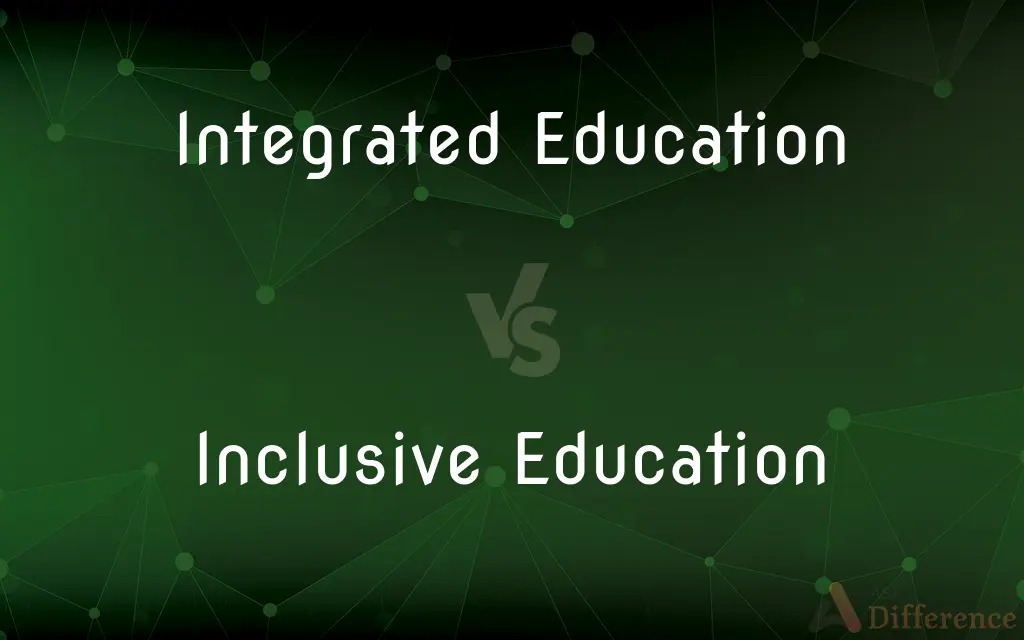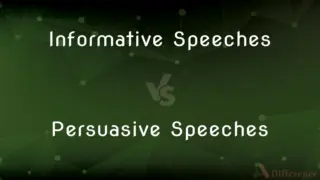Integrated Education vs. Inclusive Education — What's the Difference?
By Tayyaba Rehman — Published on January 29, 2024
Integrated Education combines students with and without special needs in the same classes, whereas Inclusive Education is a broader approach that adjusts the whole education system for diversity and accessibility for all.

Difference Between Integrated Education and Inclusive Education
Table of Contents
ADVERTISEMENT
Key Differences
Integrated Education focuses on placing students with special needs alongside their peers in traditional classroom settings, aiming for a unified learning environment. Inclusive Education, on the other hand, is a holistic approach that involves adapting the entire educational structure and culture to accommodate all students, regardless of their abilities or backgrounds.
In Integrated Education, the emphasis is on the physical integration of students with disabilities into mainstream classrooms. Conversely, Inclusive Education goes beyond physical placement, advocating for the full participation and equal opportunity for all students within the educational system, ensuring that everyone's needs are met.
Integrated Education often involves adapting existing educational practices to include students with special needs. In contrast, Inclusive Education requires a fundamental transformation of educational policies, practices, and teaching methodologies to embrace diversity in all forms.
The goal of Integrated Education is to bring students with special educational needs into general education classrooms. In Inclusive Education, the objective is broader; it seeks to change school cultures, policies, and practices to ensure that all students, including those with disabilities, are valued and able to learn together.
Integrated Education may still involve some level of separation or differentiation within a mainstream classroom. In Inclusive Education, the focus is on creating a learning environment where differences are valued and all students have a sense of belonging and equal participation.
ADVERTISEMENT
Comparison Chart
Focus
Physical integration of special needs students in regular classes
Holistic adaptation of educational system for all students
Approach
Adapting existing structures for inclusion
Transforming educational practices and policies
Goal
Placement in mainstream classrooms
Full participation and equality in education
Methodology
Modification within existing framework
Comprehensive restructuring for diversity
Outcome
Coexistence of diverse students
An inclusive culture valuing all differences
Compare with Definitions
Integrated Education
Integrated Education is the inclusion of students with special needs in regular classrooms.
Integrated Education helps students with special needs feel part of the school community.
Inclusive Education
Inclusive Education is the practice of ensuring equal opportunities for every student.
Inclusive Education helps to break down barriers that students with disabilities often face.
Integrated Education
Integrated Education combines students with and without special needs in one classroom.
In Integrated Education, children with disabilities attend the same classes as their peers.
Inclusive Education
Inclusive Education is about creating a learning environment that welcomes all differences.
Inclusive Education aims to make each student feel valued and supported.
Integrated Education
Integrated Education involves educating special needs students in mainstream settings.
The school's Integrated Education program has successfully included several students with learning disabilities.
Inclusive Education
Inclusive Education transforms schools to cater to a diverse range of learning needs.
The school's shift to Inclusive Education has been positive for students from various cultural backgrounds.
Integrated Education
Integrated Education focuses on the physical integration of diverse learners.
Integrated Education promotes understanding and acceptance among all students.
Inclusive Education
Inclusive Education is an approach that modifies the entire educational system for all.
Inclusive Education ensures that every student, irrespective of their background, is accommodated.
Integrated Education
Integrated Education is a practice of bringing together students of various abilities.
Through Integrated Education, students learn to appreciate diversity from a young age.
Inclusive Education
Inclusive Education involves adapting teaching to meet the needs of all students.
The new Inclusive Education policy at our school includes curriculum adjustments for diverse learners.
Common Curiosities
Can Integrated Education be part of Inclusive Education?
Yes, it can be a component of the broader Inclusive Education approach.
How does Inclusive Education impact school culture?
It promotes a culture of acceptance and equal opportunity for all students.
How does Inclusive Education differ in approach?
It involves transforming the entire educational system to support diversity.
Is Inclusive Education beneficial for all students?
Yes, it fosters a supportive environment for students of all abilities.
Does Integrated Education require special teacher training?
Yes, teachers often need training to effectively integrate students with special needs.
What's the main aim of Integrated Education?
To physically integrate students with special needs into regular classrooms.
How does Inclusive Education benefit students with disabilities?
It ensures they receive an equitable education alongside their peers.
Are special resources needed for Integrated Education?
Often, additional resources and supports are needed for effective integration.
What is the key focus of Inclusive Education?
To ensure that educational practices are accessible and beneficial to all students.
Does Integrated Education change the curriculum?
It may involve some curriculum adaptations, but not as extensively as Inclusive Education.
How does Inclusive Education address diversity?
By ensuring that educational practices respect and accommodate all forms of diversity.
Can Integrated Education be practiced in all schools?
It can be implemented in most schools with the right support and resources.
Are there challenges in implementing Inclusive Education?
Yes, challenges include resource allocation, training educators, and changing attitudes.
Is professional development important in Integrated Education?
Yes, ongoing professional development is crucial for teachers in Integrated Education settings.
What role do parents play in Inclusive Education?
Parents are key partners in shaping an inclusive educational environment.
Share Your Discovery

Previous Comparison
Informative Speeches vs. Persuasive Speeches
Next Comparison
Cayenne Pepper vs. PaprikaAuthor Spotlight
Written by
Tayyaba RehmanTayyaba Rehman is a distinguished writer, currently serving as a primary contributor to askdifference.com. As a researcher in semantics and etymology, Tayyaba's passion for the complexity of languages and their distinctions has found a perfect home on the platform. Tayyaba delves into the intricacies of language, distinguishing between commonly confused words and phrases, thereby providing clarity for readers worldwide.














































